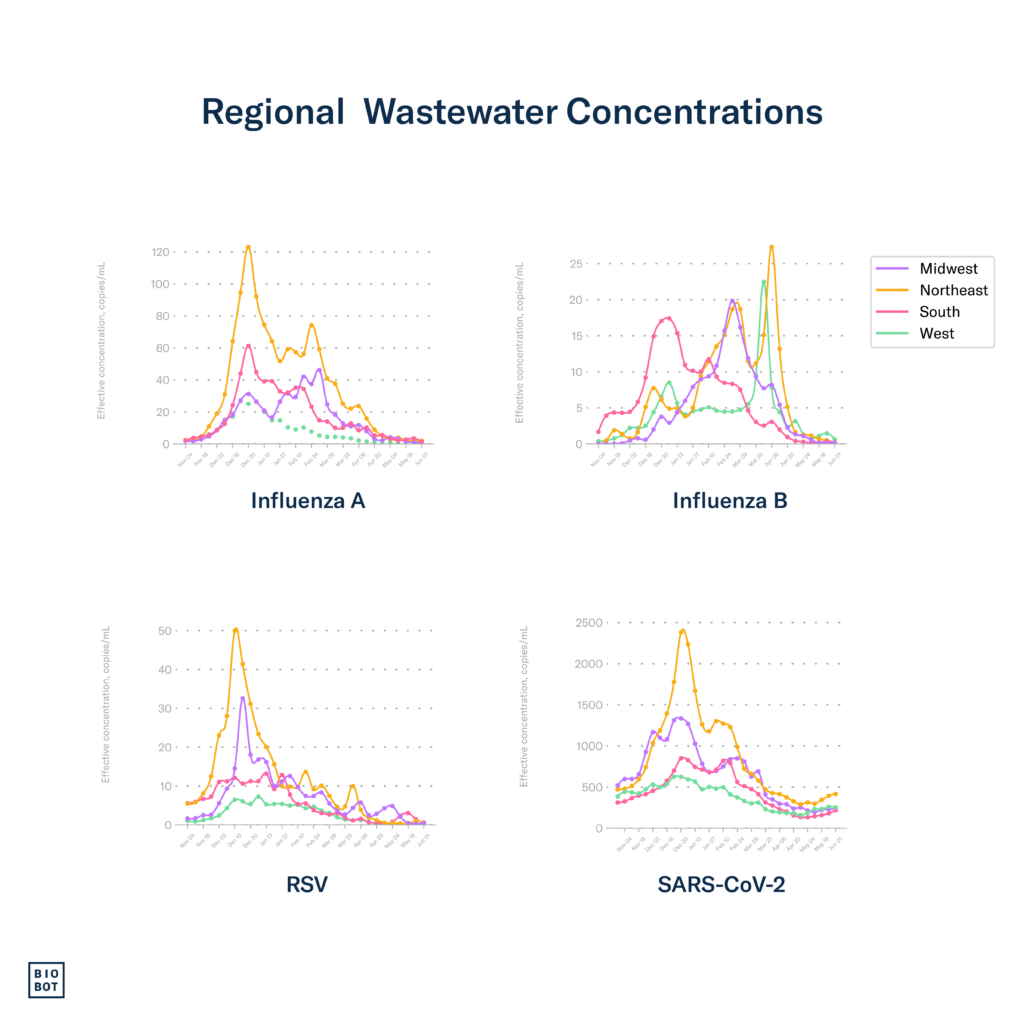Summary: Week of 6/3/24
We continue to monitor the rapidly evolving H5N1 influenza virus situation. As we do, a quick reminder that Biobot’s influenza A assay detects the H5N1 influenza subtype, which is an influenza A virus, but does not distinguish between the different subtypes of influenza A (e.g. H5N1 vs H1N1).
Thankfully, we still have not seen large, widespread increases in influenza A concentrations. Data through week 22 (June 1st) also indicate that influenza activity remains low in the four US regions. In great news, the brief uptick in national influenza A concentrations we observed last week has gone back down. We want to highlight are some important points about the role of Biobot’s wastewater data in understanding the current circulation/risk of H5N1:
- At this point, we cannot determine if any of the upticks we’ve observed are due to seasonal influenza A virus or if H5N1 could be playing a role.
- Biobot is currently testing for influenza A in 8 out of the 10 states with positive dairy herds (Texas, New Mexico, Kansas, Idaho, Ohio, North Carolina, South Dakota, and Iowa), among several other states across the country.
- Our current assays do not distinguish between infections in humans versus infected animals that are shedding into the wastewater system.
This situation is rapidly evolving and our team will continue to closely monitor H5N1. We will provide any additional information as it becomes relevant or available via Twitter and here in the risk reports.
Biobot’s national wastewater network showed decreasing and very low national concentrations of influenza A & B and RSV during week 22, while SARS-CoV-2 concentrations continued to increase. Nationally, major clinical metrics remained low for influenza, and RSV in week 21, while metrics for COVID-19 showed signs of increase. The percentage of outpatient visits due to influenza-like illness (ILI) continues to stay below the national baseline of 2.9%, currently at 1.9%. Overall, the illness burden due to respiratory viruses still remains low.
The Bottom Line: As we head into summer, we are keeping our eyes on two things: 1. Increasing SARS-CoV-2 concentrations which suggests the start of a summer wave, and 2. The evolving H5N1 situation, which thankfully does not currently pose a significant threat to human health. Closely monitoring both these situations is essential to protecting human health. Our recommendations to keep yourself and loved ones healthy remain the same: if you feel unwell, minimize contact with others, consider wearing a mask in crowded areas, and stay current with vaccinations
National Outlook
RSV
Nationally, RSV concentrations remained very low in week 22.

Influenza
After a brief and small increase in week 21, national influenza A concentrations have begun declining again in week 22. Influenza B concentrations also declined nationally in week 22 and overall, both remain low. We are continuing to keep a very close eye on influenza A concentrations as H5N1 is an influenza A virus subtype that our assay picks up.
Clinical data showed that the illness burden due to influenza held steady in week 21. Test positivity from clinical labs did not change in week 21, currently at 1.7%. The percentage of outpatient visits for influenza-like illness (ILI) – typical in flu, RSV, and COVID-19 patients – also held steady and remains below the national baseline of 2.9%, currently at 1.9%. FluSurv-NET reports that the influenza hospitalization rate per 100,000 persons also remains very low, currently at 0.2 in week 21. These metrics are at levels we would typically expect for this time of year, and indicate low influenza activity.
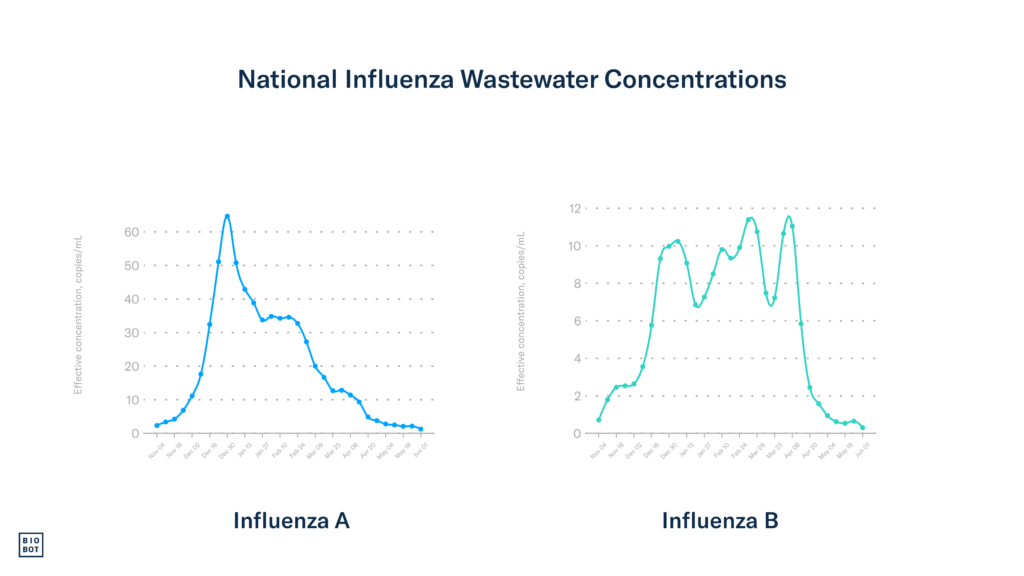
COVID-19
Wastewater data show that COVID-19 activity and community viral load increased during week 22. The national average SARS-CoV-2 wastewater concentration is now 300 copies per mL.
Clinical metrics have started showing signs of increasing COVID-19 activity in week 20. Test positivity increased, currently at 4.2%. COVID-NET reports that the hospitalization rate per 100,000 persons is 0.7 in week 21. Deaths due to COVID-19 held steady, and currently represent 0.6% of all deaths in the US.

Regional
The South
RSV: In the South, RSV wastewater concentrations remained stable and very low during week 22.
Influenza: In great news, influenza A concentrations began decreasing again in the South during week 22, and remained low. Influenza B concentrations followed a similar trend. Clinical data continues to confirm that disease burden due to influenza remains low – all Southern states remained in the Minimal ILI activity level through week 21 and none experienced increases in outpatient visits due to ILI.
COVID-19: SARS-CoV-2 wastewater concentrations increased in the South during week 22, currently at 218 copies per mL. The two Southern states in COVID-NET, an enhanced hospitalization surveillance system, are Georgia and Tennessee. Georgia and Tennessee experienced slight decreases in COVID-19 hospitalization rates in week 21, and rates in both states remained low overall.
The Midwest
RSV: RSV concentrations remained stable and very low in the Midwest during week 22.
Influenza: Influenza A & B wastewater concentrations remained stable and very low in the Midwest in week 22. Clinical data continues to show low influenza illness burden in the Midwest – all states remained in the Minimal ILI activity level. South Dakota, however, experienced a small uptick in outpatient visits due to ILI in week 21, but levels remain low overall.
COVID-19: COVID-19: SARS-CoV-2 wastewater concentrations increased in the Midwest during week 22, currently at 241 copies per mL. Michigan, Minnesota, and Ohio are Midwestern states in COVID-NET. In week 21, none of these states experienced increases in COVID-19 hospitalization rate, and rates remained low overall.
The Northeast
RSV: In the Northeast, RSV wastewater concentrations remained stable and very low during week 22.
Influenza: Influenza A & B concentrations declined and remained very low in the Northeast during week 22. In week 21, all Northeastern states remained in the Minimal ILI activity level and none experienced increases in outpatient visits due to ILI.
COVID-19: SARS-CoV-2 wastewater concentrations increased in the Northeast during week 22, currently at 416 copies per mL. Connecticut, Maryland, and New York are Northeastern states in COVID-NET. In week 21, none of these states experienced increases in COVID-19 hospitalization rates, and rates remained low overall.
The West
RSV: RSV wastewater concentrations remained stable and very low in the West during week 22.
Influenza: Influenza A & B concentrations held steady and remained very low in the West during week 22. During week 21, all Western states remained in the Low or Minimal ILI activity levels, however Wyoming and Hawaii experienced increases in outpatient visits due to ILI. While the increase in Wyoming was small, the increase in Hawaii was noticeably larger, with the percent of outpatient visits due to ILI now at similar rates observed in February. We’ll continue to keep an eye on this late-season activity in the West.
COVID-19: During week 22, SARS-CoV-2 wastewater concentrations held steady in the West, currently at 254 copies per mL. Western states in COVID-NET including California, Colorado, Oregon, and New Mexico either held steady or experienced decreases in COVID-19 hospitalizations rates in week 21, while Utah experienced a slight increase. Hospitalizations in the West remain low overall.
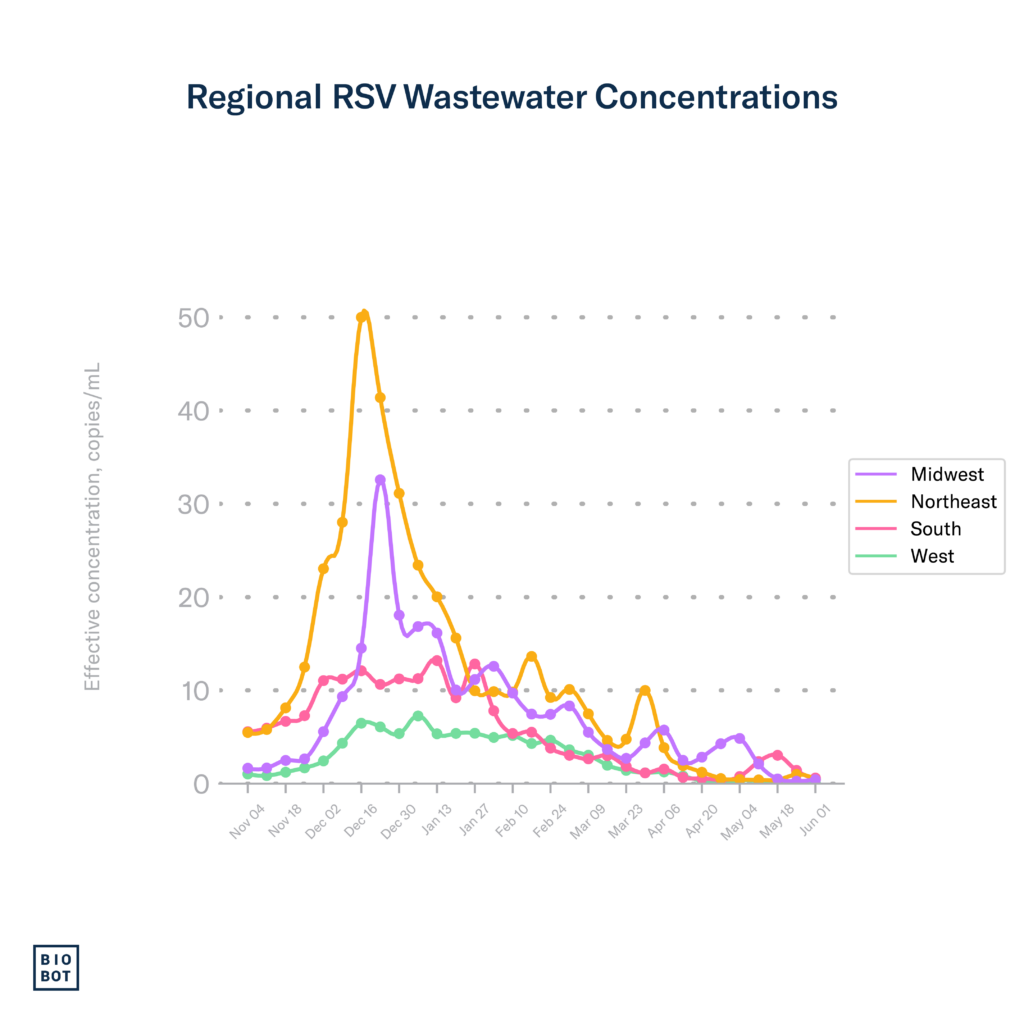
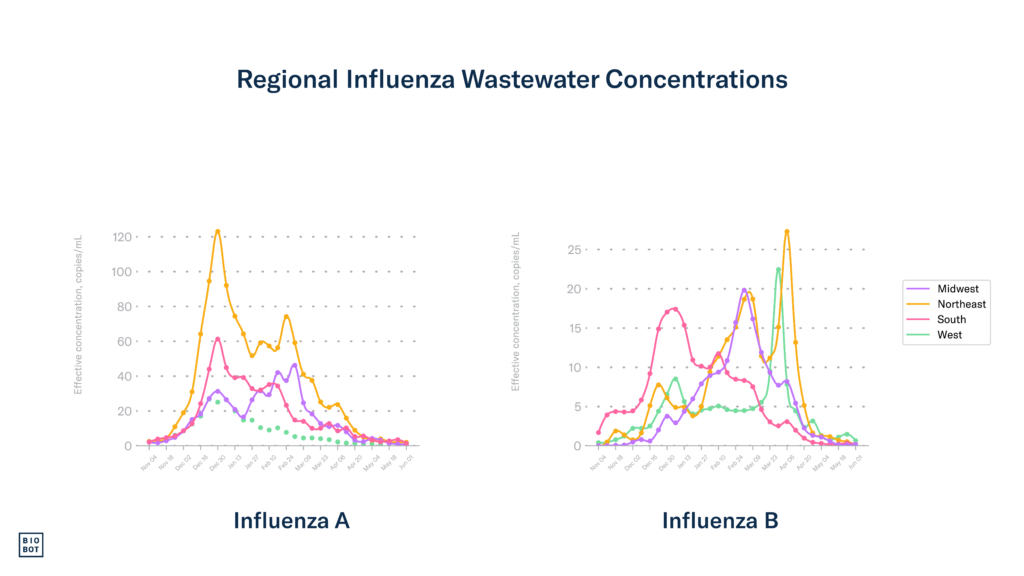
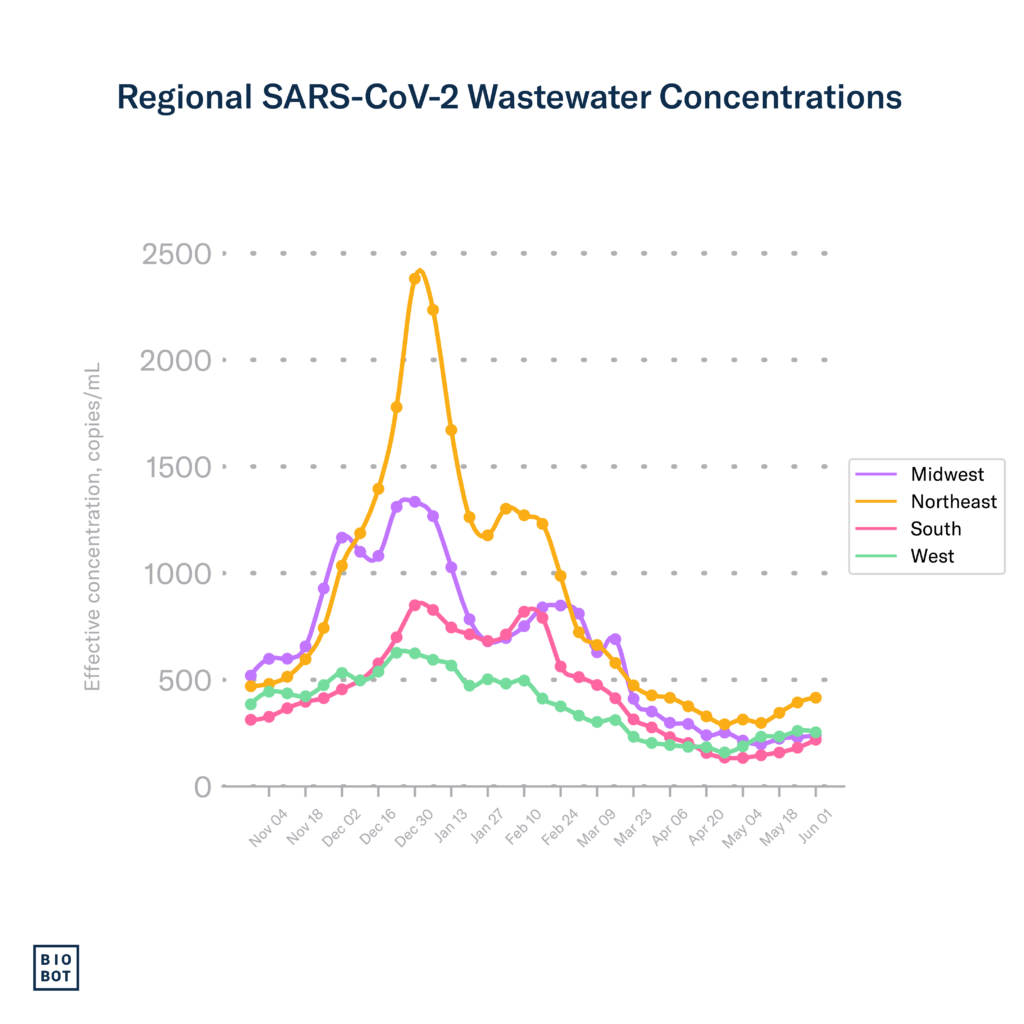
Footnotes:
Wastewater data from Biobot Analytics for RSV, influenza, and SARS-CoV-2 are through June 1, 2024 (MMWR week 22). Clinical data on testing, hospitalizations, and emergency department visits for RSV, influenza, and COVID-19 are from the Centers for Disease Control and Prevention. Updates to clinical data for RSV, influenza, and COVID-19 are through May 25, 2024 (MMWR week 21).

